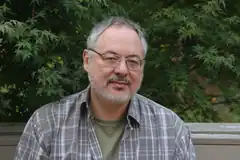 | |
| Data i miejsce urodzenia | |
|---|---|
| profesor | |
| Specjalność: kliodynamika, modelowanie procesów historycznych | |
| Strona internetowa | |
Peter Turchin, ros. Пётр Валенти́нович Турчи́н (ur. 22 maja 1957 w Obninsku)[1][2] – rosyjsko-amerykański naukowiec zajmujący się ewolucją społeczną i kulturową, biolog ewolucyjny.
Życiorys
Syn Walentina Turczina, radzieckiego dysydenta[3][4]. W latach 1975–1977 studiował biologię na Uniwersytecie Moskiewskim[5].
Dokonania
Twórca terminu kliodynamika, opisującego matematyczne modelowanie zjawisk historycznych i statystyczne testowanie teorii historycznych[6]. Rozwinął teorię strukturalno-demograficzną Jacka Goldstone’a, wyjaśniającą zjawiska niestabilności politycznej[7], oraz pokazał możliwość matematycznego modelowania cyklów sekularnych[8]. Jest współtwórcą bazy danych historycznych Projekt Seshat[9].
Turchin jest kolejnym badaczemm, który próbuje wykorzystać matematykę do badań historycznych. W najnowszej swojej książce End Times. Elites, Counter-elites and the Path of Political Disintegration (Czasy ostateczne. Elity, kontrelity i polityczna dezintegracja) sam wymienia wcześniejsze niezbyt udane próby, które spotkały się z krytyką historyków[10].
Redaktor naczelny czasopisma „Cliodynamics: The Journal of Quantitative History and Cultural Evolution”[11]. Jeden ze współtwórców Instytutu Ewolucji (Evolution Institute)[12]. Założyciel wydawnictwa Beresta Books[13].
Obecnie (2024) pracuje głównie w Complexity Science Hub w Wiedniu[10].
Publikacje książkowe
- Quantitative Analysis of Movement: Measuring and Modeling Population Redistribution in Animals and Plants (1998)[14]
- Complex Population Dynamics: a Theoretical/Empirical Synthesis (2003)[15]
- Historical Dynamics: Why States Rise and Fall (2003)[8]
- War and Peace and War: The Rise and Fall of Empires (2007)[16]
[wyd. pol. Wojna i pokój, i wojna: jak powstają i upadają imperia (2022)[17]] - Secular Cycles (razem z S. Nefedovem, 2009)[18]
- Ultrasociety: How 10,000 Years of War Made Humans the Greatest Cooperators on Earth (2016)[19]
- Ages of Discord: A Structural-Demographic Analysis (2016)[20]
- Figuring Out the Past: The 3,495 Vital Statistics that Explain World History (razem z Danielem Hoyerem, 2020)[21]
- End Times: Elites, Counter-Elites, and the Path of Political Disintegration (2023). ISBN 978-0-14-199928-9[22][23]
Przypisy
- ↑ Graeme Wood: The next decade could be even worse. theatlantic.com, grudzień 2020. [dostęp 2022-07-23]. (ang.).
- ↑ Peter Turchin: tweet z profilu Petera Turchina. twitter.com/Peter_Turchin, 15.12.2019. [dostęp 2022-07-23]. (ang.).
- ↑ Chapter 19: Peter Turchin, USA, 1957. W: Shalom Salomon Wald: Rise and Decline of Civilizations: Lessons for the Jewish People. Boston: Academic Studies Press, 2014, s. 114–114. DOI: 10.1515/9781618112774-029. ISBN 978-1-61811-377-1. [dostęp 2022-07-23]. (ang.).
- ↑ Ludmiła Aleksiejewa. Ruch obrony praw człowieka w ZSRR (II). „Wolność i Solidarność. Studia z dziejów opozycji wobec komunizmu i dyktatury”. 7, s. 114–115, 2014. [dostęp 2022-07-23]. (pol.).
- ↑ Peter Turchin: Curriculum Vitae. peterturchin.com, 2021. [dostęp 2022-07-23]. (ang.).
- ↑ Peter Turchin. Arise ‘cliodynamics’. „Nature”. 454, s. 34–35, 2008-07-02. Springer Nature Limited. DOI: 10.1038/454034a. ISSN 1476-4687, ISSN 0028-0836. [dostęp 2022-07-25]. (ang.).
- ↑ Jack A. Goldstone. Turchin, Peter. 2016. Ages of Discord: A Structural Demographic Analysis of American History.. „Evolutionary Studies in Imaginative Culture”. 2(1), 2018-04-01. DOI: 10.26613/esic.2.1.86. [dostęp 2022-07-23]. (ang.).
- 1 2 Peter Turchin: Historical Dynamics: Why States Rise and Fall. Princeton, Oxford: Princeton University Press, 2003. ISBN 978-0691116693. (ang.).
- ↑ Peter Turchin. The SESHAT Databank Project: the 2014 Report. „Cliodynamics: The Journal of Quantitative History and Cultural Evolution”. 5(1), 2014. DOI: 10.21237/C7clio5125311. [dostęp 2022-07-23]. (ang.).
- 1 2 Edwin Bendyk: Kliodynamika, czyli jak matematyka pomaga w badaniach historii. A co mówi o przyszłości?. projektpulsar.pl, 27 grudnia 2023. [dostęp 2024-01-08]. (ang.).
- ↑ The Regents of the University of California: Cliodynamics. Editorial Board. eScholarship. University of California. [dostęp 2022-07-23]. (ang.).
- ↑ Professor Peter Turchin. University of Oxford/School of Anthropology and Museum Ethnography. [dostęp 2022-07-24]. (ang.).
- ↑ Beresta Books: About Beresta Books. berestabooks.com. [dostęp 2022-07-25]. (ang.).
- ↑ Peter Turchin: Quantitative Analysis of Movement: Measuring and Modeling Population Redistribution in Animals and Plants. Sunderland, Massachusetts: Sinauer Associates Inc., 1998. ISBN 978-0878938476. (ang.).
- ↑ Peter Turchin: Complex Population Dynamics: a Theoretical/Empirical Synthesis. Princeton, Oxford: Princeton University Press, 2003. ISBN 978-0691090214. (ang.).
- ↑ Peter Turchin: War and Peace and War: The Rise and Fall of Empires. Plume, 2007. ISBN 978-0452288195. (ang.).
- ↑ Peter Turchin: Wojna i pokój, i wojna: jak powstają i upadają imperia. Warszawa: Wydawnictwo WEI, 2022. ISBN 978-83-954197-6-8. (pol.).
- ↑ Peter Turchin, Sergey A. Nefedov: Secular Cycles. Princeton, Oxford: Princeton University Press, 2009. ISBN 978-0691136967. (ang.).
- ↑ Peter Turchin: Ultrasociety: How 10,000 Years of War Made Humans the Greatest Cooperators on Earth. Beresta Books, 2016. ISBN 978-0996139519. (ang.).
- ↑ Peter Turchin: Ages of Discord: A Structural-Demographic Analysis. Beresta Books, 2016. ISBN 978-0996139540. (ang.).
- ↑ Peter Turchin, Daniel Hoyer: Figuring Out the Past: The 3,495 Vital Statistics that Explain World History. Profile Books, 2020. ISBN 978-1-5417-6268-8. (ang.).
- ↑ Peter Turchin: End Times: Elites, Counter-Elites, and the Path of Political Disintegration. Penguin Books, 2023. ISBN 978-0593490501. (ang.).
- ↑ End Times: Elites, Counter-Elites, and the Path of Political Disintegration. search.worldcat.org, 27 grudnia 2023. [dostęp 2024-01-08]. (ang.).